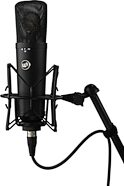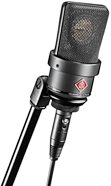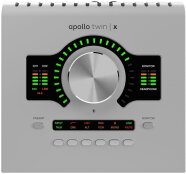Joemeek twinQ2 Dual Microphone Preamplifier and Optical Compressor
No longer available at zZounds


zZounds Gear Experts Say...
With a DI, preamp, compressor, EQ, and interface in a single unit, the twinQ2 is a must-have for home studio owners looking to upgrade their signal chain.
Overview
The Joemeek twinq2 is everything you ever wanted in a dual studio channel - and then some!
The input "GAIN" control now operates over the range 18 dB to 60 dB, with improved resolution in the crucial 25 dB-45 dB range. Microphone inputs up to +4 dBu can be accommodated without distortion (+24 dBu by using the "PAD" switch).
As before, with the "LINE" input selected the gain is unity (0dB) at the top of the dial; the gain range is now -19 dB to +22 dB.
The "INSTRument" input now has a gain range of 0 dB to +40 dB.
"PEAK" LEDs now light at +16 dBu (2 dB below Full Scale Digital).
They started with high quality Burr-Brown IC's for the preamp, added an extremely musical EQ section and an optical compressor for that signature "Meek" sound. Then Joe Meek included some new and innovative features, like an "Iron" switch that switches the IC front end to a transformer - completely changing the topology of the circuit. It even has 96 kHz/24-bit, A/D converters built in.
All of this comes housed in a rugged two space chassis with a beautifully sculpted aluminum faceplate. With sonic quality rivaling mic pre's priced thousands of dollars more, the twinq2 sets a new standard for dual channels!
The Joemeek Digital Interface has highly stable onboard master clocks for low-jitter, hi-fi results. Internal sample rates of 44.1kHz, 48kHz, 88.2kHz or 96kHz are selected by means of rear panel switches. 44.1kHz is the standard used for audio CD's, while 48kHz and 96kHz are widely used in recording studios. In general, the higher the sample rate, the better the audio fidelity, but the more disk space is required for the recording. For example, recording at 96kHz requires twice as much storage as 48kHz. Consult the manual of your recorder or DAW as to what sample rates it will accommodate.
Alternatively the twinq2 may be set to the frequency of an external master word clock, generated, for example, by the studio's recorder or DAW. When connected to the BNC socket provided, a suitable external word clock will be detected automatically and will override the twinq2's internal word clock.
The front panel LED labelled 'EXT CLK' illuminates when the twinq2 is successfully locked to an external word clock. To avoid distortion, care should be taken not to overdrive the input to the Digital Interface. The red LED next to the Output Gain control is labeled "PEAK FSD" which stands for "Full Scale Digital". read less
Upgraded Features:
The microphone input transformer is permanently assigned to the "Mic" Input. The "IRON" switch now optionally sends the "Line" input through the transformer, to add some coloration to Line sources.The input "GAIN" control now operates over the range 18 dB to 60 dB, with improved resolution in the crucial 25 dB-45 dB range. Microphone inputs up to +4 dBu can be accommodated without distortion (+24 dBu by using the "PAD" switch).
As before, with the "LINE" input selected the gain is unity (0dB) at the top of the dial; the gain range is now -19 dB to +22 dB.
The "INSTRument" input now has a gain range of 0 dB to +40 dB.
"PEAK" LEDs now light at +16 dBu (2 dB below Full Scale Digital).
They started with high quality Burr-Brown IC's for the preamp, added an extremely musical EQ section and an optical compressor for that signature "Meek" sound. Then Joe Meek included some new and innovative features, like an "Iron" switch that switches the IC front end to a transformer - completely changing the topology of the circuit. It even has 96 kHz/24-bit, A/D converters built in.
All of this comes housed in a rugged two space chassis with a beautifully sculpted aluminum faceplate. With sonic quality rivaling mic pre's priced thousands of dollars more, the twinq2 sets a new standard for dual channels!
Digital Interface
The Joemeek Digital Audio Interface provides high… read more quality digital audio outputs plus the ability to synchronize to an external word clock. The digital audio outputs are compatible with most digital recorders, as well as Digital Audio Workstations and mixers. S/PDIF format is available from the RCA phono connectors, while the transformer coupled XLR connector provides an AES3 compatible output.The Joemeek Digital Interface has highly stable onboard master clocks for low-jitter, hi-fi results. Internal sample rates of 44.1kHz, 48kHz, 88.2kHz or 96kHz are selected by means of rear panel switches. 44.1kHz is the standard used for audio CD's, while 48kHz and 96kHz are widely used in recording studios. In general, the higher the sample rate, the better the audio fidelity, but the more disk space is required for the recording. For example, recording at 96kHz requires twice as much storage as 48kHz. Consult the manual of your recorder or DAW as to what sample rates it will accommodate.
Alternatively the twinq2 may be set to the frequency of an external master word clock, generated, for example, by the studio's recorder or DAW. When connected to the BNC socket provided, a suitable external word clock will be detected automatically and will override the twinq2's internal word clock.
The front panel LED labelled 'EXT CLK' illuminates when the twinq2 is successfully locked to an external word clock. To avoid distortion, care should be taken not to overdrive the input to the Digital Interface. The red LED next to the Output Gain control is labeled "PEAK FSD" which stands for "Full Scale Digital". read less
Specs
- Input impedances: Mic: 1.2 kohm; Line: 10 kohm
- Pre-amp overall gain: -2 dB to 60 dB
- Common mode rejection: 70 dB
- Equivalent input noise: -128.5 dBu (unweighted)
- Distortion: 0.001% (below Compressor threshold)
- Frequency response: 10 Hz to 70 kHz (-3 dB)
- Maximum input before clipping: Mic: +24 dBu, +45 dBu
- Headroom before clipping: +29 dBu
- Compressor threshold: -6 dBu to -22 dBu (variable)
- Compressor ratio: 1:1 to 10:1 (variable)
- Compressor attack time: 1 msec to 100 msec (adaptive)
- Compressor release time: 0.1 sec to 3 sec (adaptive)
- Nominal output levels: +4 dBu/-10 dBv
- Output impedance: 75 ohm
- Output Level switch: 12 dB attenuation
- Noise Floor: -85 dBu (typical, with ~40 dB mic gain)
- VU Meter: Analogue movement
- Power supply: 115V / 230V ac mains, 50/60 Hz
- Power consumption: 30 W
- Mechanical: 482 W x 88 H x 220 D (overall)
- Weight: 6.6 lbs.
- High Pass Filter: 12 dB per octave cut below 80 Hz
- EQ Boost & Cut: +/-15 dB (zero phase-shift bell response)
- LF Frequency: 40 Hz to 65 0Hz variable
- MID Frequency: 300 Hz to 5 kHz variable
- HF Frequency: 6 kHz/12 kHz switchable
- Resolution: 24-bit delta sigma using Wolfson WM8738 ADC
- Sampling Rate: 44.1 kHz, 48 kHz, 88.2 kHz or 96 kHz selectable
- Output Formats: AES3 compliant (balanced), S/PDIF electrical
- Oversampling: This is [sample frequency divided by twice the bandwidth]. So for a 20 kHz bandwidth sampled at 96 kHz, oversampling = 2.4x.
- However the term oversampling is sometimes confused with [clock frequency divided by sample rate]. In the DB-1 that would be 256 x at 96 kHz
- Noise Floor: Typically 92 dB A-weighted (referenced to 0 dBFS = +18 dBu). So for a +4 dBu signal, the SNR is 78 dB
- Distortion: typically 0.01% @ 0d Bu (20 Hz - 20 kHz) at 96 kHz sample rate
- typically 0.02% @ 0 dBu (20 Hz - 20 kHz) at 48 kHz sample rate
- typically 0.02% @ -1 dBFS (20 Hz - 20 kHz) at all sample rates
- External Word Clock input: 75 ohm, 1.25 V - TTL level, 44.1 kHz to 96 kHz (auto synchronising)
- Crosstalk: typically -67 dB (20 Hz - 20 kHz)
- Pre-amp overall gain: -2 dB to 60 dB
- Common mode rejection: 70 dB
- Equivalent input noise: -128.5 dBu (unweighted)
- Distortion: 0.001% (below Compressor threshold)
- Frequency response: 10 Hz to 70 kHz (-3 dB)
- Maximum input before clipping: Mic: +24 dBu, +45 dBu
- Headroom before clipping: +29 dBu
- Compressor threshold: -6 dBu to -22 dBu (variable)
- Compressor ratio: 1:1 to 10:1 (variable)
- Compressor attack time: 1 msec to 100 msec (adaptive)
- Compressor release time: 0.1 sec to 3 sec (adaptive)
- Nominal output levels: +4 dBu/-10 dBv
- Output impedance: 75 ohm
- Output Level switch: 12 dB attenuation
- Noise Floor: -85 dBu (typical, with ~40 dB mic gain)
- VU Meter: Analogue movement
- Power supply: 115V / 230V ac mains, 50/60 Hz
- Power consumption: 30 W
- Mechanical: 482 W x 88 H x 220 D (overall)
- Weight: 6.6 lbs.
- High Pass Filter: 12 dB per octave cut below 80 Hz
- EQ Boost & Cut: +/-15 dB (zero phase-shift bell response)
- LF Frequency: 40 Hz to 65 0Hz variable
- MID Frequency: 300 Hz to 5 kHz variable
- HF Frequency: 6 kHz/12 kHz switchable
Digital interface specifications
- Sampling: 24-bit- Resolution: 24-bit delta sigma using Wolfson WM8738 ADC
- Sampling Rate: 44.1 kHz, 48 kHz, 88.2 kHz or 96 kHz selectable
- Output Formats: AES3 compliant (balanced), S/PDIF electrical
- Oversampling: This is [sample frequency divided by twice the bandwidth]. So for a 20 kHz bandwidth sampled at 96 kHz, oversampling = 2.4x.
- However the term oversampling is sometimes confused with [clock frequency divided by sample rate]. In the DB-1 that would be 256 x at 96 kHz
- Noise Floor: Typically 92 dB A-weighted (referenced to 0 dBFS = +18 dBu). So for a +4 dBu signal, the SNR is 78 dB
- Distortion: typically 0.01% @ 0d Bu (20 Hz - 20 kHz) at 96 kHz sample rate
- typically 0.02% @ 0 dBu (20 Hz - 20 kHz) at 48 kHz sample rate
- typically 0.02% @ -1 dBFS (20 Hz - 20 kHz) at all sample rates
- External Word Clock input: 75 ohm, 1.25 V - TTL level, 44.1 kHz to 96 kHz (auto synchronising)
- Crosstalk: typically -67 dB (20 Hz - 20 kHz)
Reviews
Reviewers gave this product an overall rating of 5 out of 5 stars.
(1 ratings)
Submitted January 1, 2013 by Nick Hackleman in San Mateo, CA
"This unit rocks!"
I've got a lot of nice Preamps. ADL600, SSL VDH Pres, MPA Gold, Neve clones, API clones, Jensen clones. 500 series rack stocked with all kinds of joys. This preamp just ROCKS. It's the first preamp I ever try out. The all in one idea might sound like some attention to detail was missed. But each section of the unit was put together to work amazingly well as a whole. The ease of use makes it a breeze to work with.
I consider my self pretty comfortable with compression, and it took me a while to get the hang of the optical comp. I was expecting something like of LA-2A ish, but it's a bit different. The more aggressive settings sound smoother to my ear. Now that I have the hang of it I'm smooth sailing with the comp. The quicker attack and release oddly seem much more smooth then some of the slower settings.
The Burr-Brown ICC preamps have a great tone. Warm, clear with nice highs and no harsh upper mids. Not too muddy, or exagerated low end. I've used it with a handful of mics from the U87, to the AEA R84, to the TLM103 to the SM7b to the KM85's. They all sounds great.
The "Iron" button really warms up the lo mids. Some have said it brightens up the signal, but that was not my experience. It made it seem warmer with a nice touch of musical harmonic distortion.
The Meekqulizer is FLAT OUT stunning. So musical and easy to use. It really brings my ribbon mics to life, and tames the top end of some of my German condensers. It'll cut mud, boost lows for impact, add that 12k top,…
read more
or cut harshness at 6k... and all with incredible ease. It's all there for outstanding tonal shaping. Probably the most fun EQ I've used for tracking.
The thing packs a ton of gain when you consider the input stage, comp makeup gain, and the output gain. It's close to 80dB, and quiet as a church mouse. I'm so please with this unit. I've used it on vocals, bass, acoustic guitar and amps with nothing but jaw dropping success. I have lots of more expensive options but this pre is a 'go to' for me.
I do wish it had an adjustable hi pass filter. It can often really thin out the signal. The onboard one is just a one button select and digs a bit deep. Often I end up using the low frequency section to kinda roll off that base if needed. It just sounds more natural.
Musical Background:
Instrumentalist for 15+ years. Music producer for 10+ years/
Musical Style:
Everything under the sun... read less
Musical Background:
Instrumentalist for 15+ years. Music producer for 10+ years/
Musical Style:
Everything under the sun... read less
9 of 9 people (100%) people found this review helpful. Did you?
Thanks for your opinion!
No longer available at zZounds
In most cases, a product is unavailable because it has been discontinued by the manufacturer
This is a carousel with product cards. Use the previous and next buttons to navigate.












